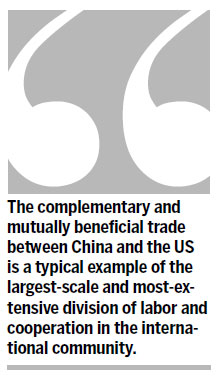Trade surplus or false alarm
Updated: 2012-01-21 09:02
By Zhou Shijian (China Daily)
|
|||||||||||

US refuses to admit the benefits of bilateral trade and is ignorant of the damage its financial crisis has caused to China's economy
The Wall Street Journal published an article on Sino-US trade last year, arguing that the flow of goods from China has deeply undermined the United States. The article quoted three American researchers as having said that the economic compromises the US has had to make because of competition from China are far beyond people's imagination.
This indeed is a fallacy.
Sino-US trade has flourished since the establishment of diplomatic ties between China and the US in early 1979. Statistics from the US show that the bilateral trade volume increased from a meager $2.37 billion in 1979 to $456.8 billion in 2010, a 193-fold increase. Also, Sino-US trade accounted for 14.3 percent of the US' total foreign trade volume in 2010. If bilateral trade had not been conducted on a mutually beneficial basis, such a considerable trade growth would not have been possible.
In fact, deepening mutual benefit, reciprocity and interdependence have made China and the US strategic trading partners now.
Given their different development stages, China and the US complement each other in many ways in their industrial structure. The complementary and mutually beneficial trade between China and the US is a typical example of the largest-scale and most-extensive division of labor and cooperation in the international community.
In the early 1980s, the US underwent its third industrial structural adjustment, which caused an exodus of a large number of labor-intensive industries overseas. This trend concurred with China's reform and opening-up policy and its efforts to absorb foreign funds and develop processing trade, thus facilitating cooperation between the two countries. Take shoemaking for example. In 1976, US shoemakers made about 53 percent of the leather shoes available in the American market. But now, China exports 80 percent of the leather shoes sold in the US.
Most of the goods China exports to the US are quality but inexpensive products of daily use that cater to American market demands. These Chinese exports have helped ease inflation in the US and served as a necessary supplement to the US' industrial structural adjustment and economic development.
According to a Morgan Stanley estimate, China had a $229.2-billion surplus in its trade with the US from 1996 to 2003, but the export of huge amounts of quality but inexpensive Chinese goods to the US helped American consumers save as much as $600 billion. Such exports have also helped American manufacturers to reduce their production costs and the US government to curb inflation.
International trade is based on mutually complementary advantages. Chinese workers' per hour wages on average is $1.5, whereas their counterparts in the US make $18 to $20 an hour. If American workers were to make labor-intensive products such as leather shoes today, many US consumers would not be able to afford them.
The strength of the US lies in high technology. To give just one example, China has bought more than 600 large Boeing jets since 1980. If just one Boeing 747 costs more than $100 million, one can imagine how many high-paying jobs China has helped maintain and/or create in the US. In return, China can only sell about 50 million pairs of leather shoes to fill the trade gap.
China is not only the biggest exporter to the US, but also the fastest-growing market for US exports. China was the 11th largest market for American exports in 2000, but it became the third largest in 2007, that is, it jumped eight places in just seven years. According to statistics from the US-China Business Council, US exports soared 465 percent between 2000 and 2010, while the average increase in US exports to other trade partners was only 56 percent.
According to the October 2010 blueprint of the US Department of Commerce, which aims to double exports to its top 10 markets in five years, American exports to Canada and Mexico on average will increase by only 2.4 percent and 3.7 percent a year, while those to China will increase by 16.7 percent. (Actual US exports to China increased by 32 percent in 2010.) Therefore, it is obvious that US President Barack Obama's plan to double US exports in five years cannot be realized without the huge Chinese market.
The US should calculate how many US jobs its exports to China help maintain and/or create to realize that the benefits of bilateral trade far outweigh the drawbacks.
With the robust growth of bilateral trade, US investments in China have increased (and are increasing) fast. From 1980 to late June 2011, the US' real investment in China reached $66.9 billion and US capital funded more than 60,000 enterprises in the country.
A survey conducted by the American Chamber of Commerce in China shows that the profit of 85 percent of American enterprises in China increased in 2010. Besides, about 40 percent of the products China exports to the US are made by American companies in China. That is to say, these companies' exports are calculated as part of China's trade and go on to make China's trade surplus, whereas the profits are pocketed by American entrepreneurs and remitted back to the US. But the US government and Congress always use the trade surplus as an excuse to pressure Beijing to revaluate the yuan further against the dollar.
Perhaps it is time Chinese scholars figured out how much damage the US financial crisis has caused to the Chinese economy.
The author is a senior researcher at the Center for US-China Relations, Tsinghua University. The article first appeared in the Global Times.
Related Stories
Trade groups program to promote Sino-US trade 2001-10-18 13:55
Time to lift Sino-US trade to new level 2010-12-23 07:55
Commerce minister calls for stronger Sino-US trade ties 2009-04-28 11:20
Sino-US trade falls in second half of 2008 2009-01-14 07:32
- Luxury looks to cash in on Dragon
- Hisense sees net profit up by 16.7% in 2011
- China's Jan new loans at least 900b yuan
- Exchange looks to upgrade to exploit resources
- China Southern to boost capacity by 10 percent to match travel demand
- iPhone launch doesn't break the stratosphere
- Food outlets raise prices as operating costs rise
- China's 2011 fiscal revenue up 24.8%








